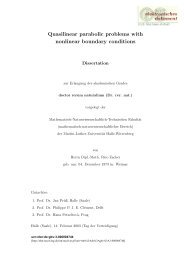Solubilisierung stark lipophiler Arzneistoffe in lipidhaltige ...
Solubilisierung stark lipophiler Arzneistoffe in lipidhaltige ...
Solubilisierung stark lipophiler Arzneistoffe in lipidhaltige ...
Sie wollen auch ein ePaper? Erhöhen Sie die Reichweite Ihrer Titel.
YUMPU macht aus Druck-PDFs automatisch weboptimierte ePaper, die Google liebt.
Summary of the Work<br />
Solubilization of Highly Lipophilic Drugs <strong>in</strong> Mixed Micellar Systems<br />
and its Influence upon Drug Absorption Process<br />
Summary<br />
It is well known that lipid conta<strong>in</strong><strong>in</strong>g mixed micelles show many beneficial features as<br />
pharmaceutical carrier systems, especially because of their ability to improve drug<br />
absorption <strong>in</strong> general and the aqueous solubility of lipophilic compounds <strong>in</strong> particular.<br />
This <strong>in</strong> turn implies their use as very promis<strong>in</strong>g carrier systems for highly lipophilic drugs.<br />
However, it is less known about the factors which may <strong>in</strong>fluence the <strong>in</strong>corporation of<br />
such drugs with<strong>in</strong> the structure of such systems and thus may affect drug solubility <strong>in</strong><br />
them. The same applies also to the factors, which may affect the delivery process of<br />
highly lipophilic drugs carried by these vehicles at biological membranes, especially the<br />
mucosal membrane of the gastro<strong>in</strong>test<strong>in</strong>al Tract. Therefore, these factors were subject<br />
of <strong>in</strong>vestigation throughout the present thesis work.<br />
Surface active agents used to develop the micellar systems were chosen among the frequently<br />
used surfactants for pharmaceutical purposes. Systematical solubilization tests<br />
were conducted to select one representative of each of the ma<strong>in</strong> three surfactant groups,<br />
the anionics, the cationics and the nonionics, for further experimentation. Lipids added<br />
to form b<strong>in</strong>ary and ternary mixed micellar systems were saturated and unsaturated Soya<br />
lecith<strong>in</strong>s (P90H and P90G respectively) as well as stearic acid (SS) and oleic acid (OS).<br />
The most important used surfactants were Brij® 35 (Br35), sodium glycodeoxycholate<br />
(NaGDC) and hexadecyltrimethylamonium bromide (HTAB). Testosterone and its<br />
propionate, enanthate and undecanoate esters (T, TP, TE, and TU) were used as model<br />
drugs to <strong>in</strong>vestigate the solubilization and absorption of highly lipophilic drugs.<br />
First, the solubilization of lipids <strong>in</strong> simple surfactant systems and <strong>in</strong> b<strong>in</strong>ary<br />
(lipid+surfactant) systems was tested. The solubilization of the unsaturated lipids (P90G<br />
and OS) <strong>in</strong> the studied micellar systems was dist<strong>in</strong>ctly higher than it was for their<br />
saturated analogues (P90H and SS), regardless of the used surfactant. In the case of<br />
HTAB or Br35, added P90G and OS <strong>in</strong> order to form ternary systems were found to<br />
have no significant <strong>in</strong>teractive <strong>in</strong>fluence on their mutual solubilization values. In contrast,<br />
the addition of one lipid to the micellar system of sodium glycodeoxycholate (NaGDC)<br />
decreased considerably its solubiliz<strong>in</strong>g capacity for the other added lipid.<br />
Based on the results of first experiment series the solubilization of the drugs was<br />
<strong>in</strong>vestigated <strong>in</strong> micellar systems (drug/surfactant) and <strong>in</strong> b<strong>in</strong>ary mixed micellar systems<br />
(drug/lipid+surfactant). Among the studied surfactants, the highest solubilization results<br />
of testosterone and its esters were achieved <strong>in</strong> the micellar and the developed mixed<br />
micellar systems of HTAB. With the exception of one case, which is the solubilization of<br />
testosterone <strong>in</strong> the micellar systems of HTAB, a marked improvement <strong>in</strong> the<br />
solubilization of the studied steroids was achieved us<strong>in</strong>g the mixed micellar systems <strong>in</strong><br />
comparison with their lipid free analogues. This was ascribed ma<strong>in</strong>ly to an <strong>in</strong>creased<br />
lipophilicity <strong>in</strong> the <strong>in</strong>terior of aggregates as well as to the growth <strong>in</strong> aggregate sizes<br />
follow<strong>in</strong>g the lipid addition. Moreover, the double bonds of the added unsaturated lipids<br />
were accounted for a facilitated embedd<strong>in</strong>g of the steroid molecules with<strong>in</strong> the<br />
aggregates by reduc<strong>in</strong>g the adhesion of the hydrocarbon cha<strong>in</strong>s or the Laplace pressure<br />
<strong>in</strong>side the aggregates, and by <strong>in</strong>teract<strong>in</strong>g with the polar functions of embedded steroids.<br />
The optimized b<strong>in</strong>ary systems showed the best solubiliz<strong>in</strong>g capacities toward the tested<br />
model drugs, as compared to their correspond<strong>in</strong>g ternary mixed micellar systems. These<br />
optimized b<strong>in</strong>ary Systems were mixtures of OS with HTAB or Br35 as well as the mixture<br />
of P90G with NaGDC.<br />
103










